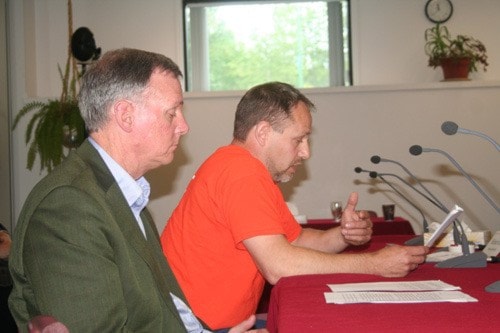Steve Zika, Hampton Affiliates chief executive officer and Richard Vossen, Babine Forest Products woods manager made a joint presentation to the special committee on timber supply held in Burns Lake last week.
The committee’s is considering recommendations that could increase timber supply, including changes to land use objectives and rates of harvest and the conversion of volume based tenures to area based tenures.
The all party committee that includes four B.C. Liberal and three NDP MLAs was appointed in May 2012 to make recommendations to address the loss of mid-term timber supply due to the mountain pine beetle epidemic, and its decision will ultimately determine the rebuilding of Babine Forest Products.
Hampton Affiliates, the majority owner of Babine Forest Products is requesting a one million cubic metre annual fibre supply.
Zika said, "Hampton is prepared to invest in Burns Lake beyond what is covered by our insurance, but the longer we wait for the answer on timber supply, the bigger our financial challenges become. Our competitors know this and they believe they just have to bog this process down to eliminate the competition from Burns Lake. The government previously forced West Fraser to divest its sawmills in the Lakes District because of its size and dominance in order to create competition. If the sawmill is not rebuilt, then West Fraser and Canfor, the two largest saw milling companies in North America, will control most of the logging and saw milling along Hwy. 16. A joint venture between a family owned company like Hampton and First Nations is a much better answer for the province."
Vossen said, "We really do believe there are options out there that we can improve that mid-term timber supply and ensure we have enough fibre in this timber supply area. We've hired an independent consultant that will do our own timber supply analysis for the lakes timber supply area. We question some of the numbers of the chief forester and we'd like to verify them ... we'd like to see where the differences are."
Vossen said he expects the report to be complete before the timber supply committee wraps up and said he would like the opportunity to present the report to the committee before they make their final decision.
"The current annual allowable cut has been set by the chief forester at two million cubic metres over the next 10 years to salvage dead pine with the assumption that we'll minimize the amount of harvesting of green fibre. We believe that we need to lower the annual allowable cut to a million cubic metres immediately to conserve green fibre that's being harvested and use this fibre for the mid-term. In the last year we've had licensees harvesting up to 40 per cent non-pine. That is fibre that we can utilize for the short and mid-term. We could conserve three million cubic metres of non-pine green fibre over the next few years."
Vossen also said that more work needs to be done around silviculture and ground sampling. He said Hampton Affiliates is also not proposing to remove visual quality management. "We completed a re-inventory of Babine Lake and found that the landscape was 20 percent overestimated. Basically, 20 percent of the landscape wasn't even visible from the lake, but it was considered a part of that visual landscape. By relaxing visual constraints, we can harvest dead pine longer and conserve non-pine species," he said.
Zika added, "We're asking for our annual license of 450,000 metres to be converted to an area based license North of Hwy. 16, where we have the road systems, logging infrastructure and tug and barge operations to feed Babine Forest Products and Decker Lake Forest Products. The remaining annual harvest should be allocated to Burns Lake Native Development Corporation or First Nations, with the restriction that the logs be delivered to Lakes District mills at fair market value. If we want to compete in the global commodity market, which you have to do when you're competing against Houston that makes 500 million board feet or Fraser Lake that makes 400 million feet, you can't build a teeny little mill and get those economies of scale."
The committee wraps up their final meeting in Kamloops on July 12, 2012 and is expected to hand down their decision on Aug. 15, 2012.
